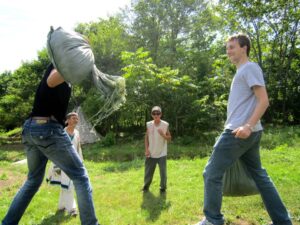Have you ever been curious about who lived in Russia’s Far East before the Russians? Well, the Paleo Village is just the place to learn about the ancient inhabitants of the Asia’s far eastern shores. Located near the city of Nakhodkha (Находха), about three hours from Vladivostok, the “Paleo Village,” an open-air museum, is located on top of an archeological dig site that is still in use today. I was given the chance to visit the museum thanks to the teachers at VGUES through my program with The School of Russian and Asian Studies.
If you don’t go with a student group, getting to the museum might be a bit of work, but it is definitely worth the trip. Our excursion, entirely in Russian, began with a time-travel-esque tour through the various epochs of the Far East. Beginning in the Stone Age, our group was shown how the region’s first inhabitants, the Udegetsi (Удэгецы), survived the harsh environment nearly 30,000 years ago. Our tour guide, sitting inside a replica teepee, demonstrated how the natives created tools out of sharp stones to be used for hunting and fishing. We were even given the opportunity to try our hand at making fire using an ancient device.
We next traveled into the Neolithic and Iron Ages, where we were treated to “traditional Udegetsi tea,” which the museum staff informed us was made from the very same berries that grew in the region during those times long past.
After learning about the tribes’ earliest homes, we were invited to participate in several Udegetsi games. As the first residents of the region were primarily hunters and fishers, children’s games focused on making each member as fit as possible. We jumped, fought, shot bows and arrows, and even had a friendly “fishing” competition, all with the goal of making us more productive members of the Udegetsi tribe.
Returning to the modern day, the focus of the tour turned towards the scientific aspect of the museum, that is, its archaeological importance. Group members got to try their hand at being archaeologists. Equipped with shovels and spades, we carefully dug up and sifted through the dirt, looking for archeological finds (археологические находки) in a 10×10 meter section called a matrix. There were also small “archaeology puzzles” available to be solved, like putting together the pieces of an ancient pot. Continuing our study of archaeology, we were led on a hike to see where the archaeologists discovered their original findings. After a few minutes of walking up a dirt path, we came across a moss-covered hedge, which very clearly marked the entrance of the ancient village discovered by the archaeologists. A little further along the path and we got our first glimpse of the archaeological dig, an area about one hundred meters by one hundred meters. Walking around this space, with the sun throwing its occasional rays on the ground, I really got a feeling for what it was like to live there thousands of years ago.
Returning to the main part of the museum with this sensation, I felt prepared to participate in the next part of the tour, a ceremonial blessing from a “shaman” (really just the tour guide dressed up in the traditional shaman clothing). Holding hands, we jogged in a circle to the beating of drums and the ringing of bells. Following this, our tour group was offered ribbons to tie to the trees, symbolizing a wish we could make from the spirits of the land. Each color represented a different type of wish. Red was for a healthy family life, blue, for good grades in school, and green, for money. (I felt I needed a lot of help, so I took all three!) The tour ended in lunch, which consisted of pilaf (плоф), tomatoes (помидоры), ginger bread (пряник), and tea (чай).
All in all, I would highly recommend this tour to anyone interested in not only learning the history of the region’s ancient inhabitants, but especially those who want to get a feeling for what it was like to live in the Primorsky Krai 10,000-30,000 years ago. In order to get to the museum, you either have to arrange a ride through a tour agency (which might be the easiest way), or take a bus to Nakhodka and then catch a taxi to the museum, outside the town, near the village of Ekaterinovka. If interested, perhaps contact the tour agency Lucky Tour (luckytour.com), and they should be able to help set up a bus or taxi for your convenience, or call the museum (4236) 65-88-86 and ask for directions to give a taxi. Also, the museum also allows people, of any age, interested in helping the archaeologists that come every summer, to come and volunteer.
Paleo Village
Near Nakhodka Village, 3 hours from Vladivostok
Open from 10am to 6pm, Closed Mondays
Entrance: 1000-1500 Rubles (not including transportation)











